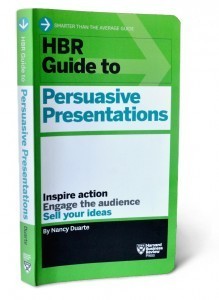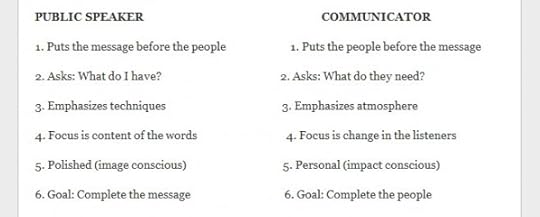Nancy Duarte's Blog, page 27
October 9, 2012
Nancy’s New Book on Shelves Now

Nancy was asked by the fine folks at Harvard Business Review to create the HBR Guide to Persuasive Presentations, which covers everything from development to delivery.
The comprehensive go-to guide is a distillation of 25 years of VisualStory™ experience, featuring highlights from Resonate and Slide:ology, as well as new insights on presentation delivery (including remote presenting!) and impact analysis.
The book offers real world advice to help you:
Win over tough crowds
Organize a coherent narrative
Create powerful messages and visuals
Connect with and engage your audience
Show people why your ideas matter to them
Strike the right tone, in any situation
Measure the impact your presentation makes
Dive right in and buy the book, or download a free section.
Watch the video below to hear Nancy break down its benefits. (And spill the beans about the upcoming eBook & case study video.)
Enjoy, and keep us posted on how it improves your presentations!






September 25, 2012
Seeya Next Summer, Spirit Week

Saturday marked the beginning of Fall. Which means it’s the end of summer, bummer.
To celebrate the new season, join us in reminiscing about our favorite summer event, Spirit Week. This year’s event included a Family Feud, a giraffe-painting party, a Wiffle Ball Tournament, and a field trip to see our beloved San Francisco Giants – who just clinched the NL West Championship title.
As you can see in the video, a good time was had by all*.
*Except Dan on Monday, when nobody could make it to play Cranium. Wanh wanh.






September 19, 2012
Winning the Story Wars – Jonah Sachs is Leading the Charge

We were thrilled to welcome author Jonah Sachs for a visit to the shop. Jonah is the co-founder and CEO of Free Range Studios, and his first book, Winning the Story Wars, came out in July. In it, he champions the power of story and stresses that great stories are the best way to reach people with your message. (I couldn’t agree more.)
His book invites marketers to become modern day mythmakers and create memorable stories that people want to share. Jonah draws examples from mythology, psychology, and history, as well as his own work. His company has created viral videos like the Meatrix and The Story of Stuff, and the success of videos like these strengthened his belief in the importance of story.
I invited Jonah to share his take on story with the entire company. After his presentation, we say down for a short interview. Enjoy!
Interview with Jonah Sachs
Book Trailer: Winning the Story Wars
Winning the Story Wars – The Myth Gap from Free Range Studios on Vimeo.






August 29, 2012
Nancy is 50! And still as hot as this super-hot deal.

Our fearless leader is officially 50! In true Nancy fashion, it’s her birthday, and she’s the one giving gifts.
To celebrate turning the big 5-0, she’s givin’ 50% off all our best stuff – The Resonate iBook, all the diagrams on Diagrammer.com, and every workshop we’ve got in 2012 – against our better judgement.
Best part is, it lasts all week long. So you’ve got until midnight on Monday, 9/3 to snap up the savings before you go back to school, or after you get back from Burning Man.






August 7, 2012
Fire & Photography | A Duarte Field Trip

On the longest day of the year, a group of Duartians set out for a special nightime version of our Photo Field Trip. We waited out the sun, expecting to capture a few looong exposure shots of the nearby CalTrain, and maybe try a little light writing.
Then darkness fell, Dan opened his duffel bag, pulled out some equipment, and casually mentioned that he knew how to spin fire. Duarte is kind of like that – you never know what someone’s got up their sleeve, or in their duffel bag, and it will always amaze you.
Video by the oh-so-talented Joe Perez.






July 31, 2012
3 Presentation Lessons from Comic-Con 2012

First of all, let me come clean. I am not a fanboy of any kind. You won’t see me waiting in line to see the latest superhero, action movie. I own exactly zero comic books. And I’m not a big fan of storylines where most of the action occurs in space.
I say this not to put down these genres (Some of my best friends are geeks!), but to say I’m probably not your ideal Comic-Con audience. (For those of you in the same camp, Comic-Con is annual convention that celebrates popular culture with an emphasis on the comic arts, fantasy and sci-fi, gaming and anime). So, when my fellow content developer, the extraordinary Doug Neff, invited a few of us down to San Diego for the event, I went mainly for the others in the group who were definitely big fans.
I didn’t really think I’d get a lot out of panels on the upcoming issue of blah, blah, blah or previews of such-and-such show. I’d be wrong.
At Duarte, the content development team spends a lot of time taking complex information, distilling it, and crafting it into a narrative that will appeal to audiences. To do this, we find it most helpful to draw on our knowledge and experiences to create simple yet compelling metaphors that make an idea come alive in the audience’s mind. And we encourage our clients to do the same. These ideas are the currency with which you buy your audience’s attention, and they come from the most unexpected places.
A prolific speechwriter once told me, “Don’t be afraid to be interested in anything. You never know when you’ll be able to use it.” And Comic-Con was a great example.
The estimated 144,000 people that attended the convention provided plenty of fodder for the months to come, but if I had to narrow down the wealth of creativity to three key lessons for presentation creation, they would go as follows:
1. Never pass up an opportunity to delight your audience.
There are a lot of audiences at Comic-Con. Some are sitting in chairs at a panel. Still more are walking the halls of and the streets outside the convention center. And nobody knows this last audience better than the people who dress up as their favorite characters and parade around the venue. I learned these costumes aren’t just a way for people to show love for their comic-book crush, but an opportunity to delight complete strangers with the novelty and the details involved with their get up.
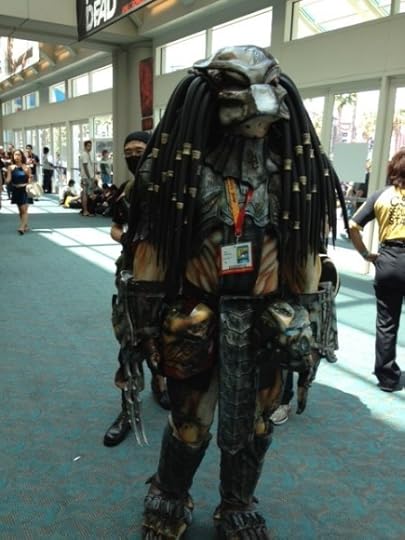

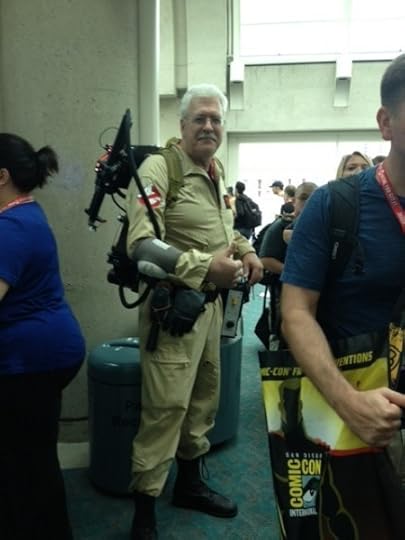
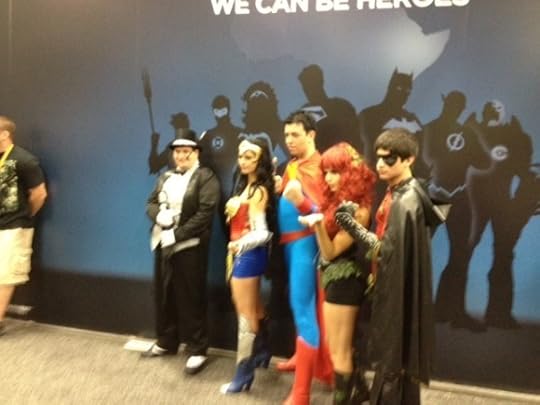
Now, I’m not saying show up to your next presentation as The Hulk (although that would be entertaining). It’s all about what would delight your audience. If that’s The Hulk, then so be it. But more often than not it’s an idea that comes from your intimate knowledge of the people to whom you’re speaking.
2. Don’t underestimate the power of a S.T.A.R. moment.
A S.T.A.R. moment is Something They’ll Always Remember. Steve Jobs famously created one when he pulled the original iPod out of his jeans pocket. Brain scientist Jill Bolte Taylor carried out another — literally — when she brought a human brain onto the TED stage in 2008.
DC Comics had one up their sleeve this year at their Batman panel. As the discussion of one of the upcoming storylines was going on, a man approached the microphone where members of the audience can ask questions. Questions are usually saved until the end, but this man interrupted the panel, threw his hands up in the air, and insisted that his question be answered now. Turns out this man wasn’t the rabid fan we all thought he was, but the Vice President of Marketing for DC Comics John Cunningham and we were all getting exclusive villain masks from the new Batman series. The crowd went wild, and the masks became a sought after item, selling on eBay for as much as $70.
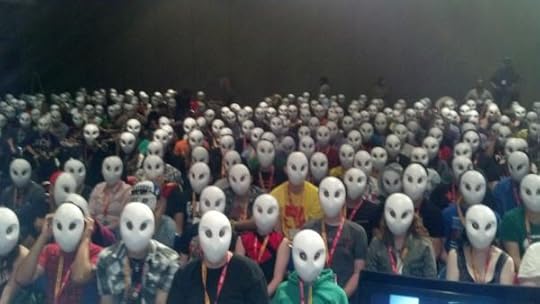
Posted on Twitter by Scott Snyder @Ssnyder1835, writer of Batman.
3. Investigate everything.
I came to Comic-Con as an outsider, not knowing anything but that I wanted to go to the Glee panel. But the art, the exhibitors, and even the people sitting in line next to me were so interesting, that pretty soon I was grabbing every handout I could, asking people around me about what they were seeing, and taking notes on ev-er-y-thing.
One of my favorite things was the experiential marketing done by the upcoming television event, Coma. They had people traipsing the streets of San Diego dressed as doctors and patients, complete with IV poles. “Don’t listen to the patients,” the doctors said, as their patients staggered around mumbling. “It’s really important that you go to J and 10th as soon as possible.” That’s where the show’s exhibit was located. They even wrapped a hospital bracelet around my wrist with all the pertinent information. Will I watch Coma? I’m not sure. Will I find a way to use that in a presentation? You betcha! Absorb ideas from everywhere. You’ll never know where you’ll use them.






July 13, 2012
Presentation #FAIL: Habitudes for Communicators

I love this great video about presentation #FAIL created by Tim Elmore.
Check out the scribble on the whiteboard in the back “something still here from an earlier presentation”.
This is a promo video for his fantastic visual book on communications. This book is full of FRESH insights that I haven’t seen in any other presentation book, so it’s worth picking up!
It’s rare for me to read a book on presentations and learn something but I did in this book! Elmore uses sticky metaphors that help you remember the concepts. His chapter heads are metaphorical like “Windows and Mirrors”, “the Faded Flag” and “The Thomas Nast Principle.” He has great insights throughout the book. For example, in “Windows and Mirrors” he proposes that there’s a gap between communicators and public speakers:
At the end of each chapter is a quiz, but he’s also put those questions into an online assessment to rank yourself to see how you’re doing as a communicator. He asks questions like “I tend to focus on being simple more than comprehensive”. It shoots out a score when you’re done.
His book is visual which of course I love.
Speaking of visual books, Garr Reynolds of PresentationZen.com fame has re-released his book by the same name. This book has many extras not included in the original so it’s thicker and better!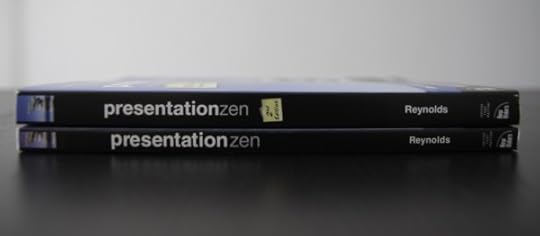






June 21, 2012
Your Audience’s Audience

In 2006, Microsoft CEO Steve Ballmer stood in front of an audience of software developers and thanked them for building applications that run on Windows. He really, REALLY wanted them to know that he recognized how important they were to the future of Microsoft and that he personally appreciated all of their efforts. And so he did this:
At the time, Ballmer probably had no idea that a video of his talk would end up on YouTube—or that somebody would turn it into one of the most frightening dance remixes of all time. As far as he knew, he was only speaking to three kinds of people—developers, developers, and developers.
Fast forward to June 18 of this year, when Ballmer stood in front of an audience of reporters and bloggers to announce the launch of Surface, Microsoft’s new tablet PC. This time he knew that his audience was larger than just the people in the room—his presentation was likely to be viewed by millions of consumers who are curious about how this new device will be different from that other tablet.
There has already been plenty written about the content and style of Ballmer’s keynote, but what interested us the most was how he used the presentation to speak to two audiences at once—the bloggers in the room and the consumers at home.
When you watch the presentation, you’ll notice that the entire production—from the messaging to the staging—was choreographed with both audiences in mind. His slides featured large images, simple fonts that can easily be read in a YouTube-sized video window, and a clutter-free template that keeps the viewer focused on the speaker and the product during video close-ups.
Of course, most of us don’t have the luxury of recording our presentations and distributing them to millions of people. But there’s an important lesson here about how to give presentations a life beyond the boardroom. It’s not enough to think about how your presentations will be received by your audience—because they might not be the only people you want to influence. In many cases, it’s your audience’s audience that needs to hear your message.
And so it’s worth asking yourself: Once your audience leaves the room, how can you be sure that they are both willing and able to share your idea with others? Will you design your presentation so that others can deliver it, as well? Will you support your presentation with multimedia or follow-up communications that extend the life of your message? And, most importantly, will you give your audience a clear call to action that inspires them to spread your idea?
As for Microsoft, we’ll be watching to see whether their consumer-focused communications strategy pays off. That said, the real key to the success of Surface might very well be Ballmer’s pitch to application developers. Can’t wait for that one.






June 19, 2012
Interview: Erik Hersman, TED Fellow & Founder of iHub

Michael Duarte interviews Erik Hersman, an influential blogger, TED Fellow, and founder of iHub, an organization designed to create a supportive hub for Africa’s tech community. Erik discusses his organization, and how presentations have affected his journey from startup to success.
Erik Hersman Interview with Michael Duarte from Duarte on Vimeo.






May 15, 2012
*New* 2Day VisualStory Workshop – June 27 & 28

By popular demand, we’ve added another date to our 2Day VisualStory lineup! If you missed out on getting a seat at the April or July sessions, join us on June 27 & 28.
Register here:
https://www.duarteshop.com/2dvisualstory-jun-27-2012.html

2Day VisualStory™ Event Details
When you combine the persuasive power of the spoken word with memorable visuals, your ideas become unstoppable. In Duarte’s two-day deep dive into VisualStory™, you’ll write your next presentation using the power of story structure, and storyboard slides using effective visual display of information. You’ll walk in with an idea and leave with that idea developing into a persuasive visual story.
Who should attend:
Anyone who has critical persuasive communication to deliver and has an influential leadership role. Primarily senior manager level and above who write their own content and use slides to express their insights visually. During the two days, you will begin to write and storyboard your next critical presentation and be transformed as a communicator.
What to bring:
Each participant needs to have a presentation idea s/he wants to write and storyboard. This could be an old one in need of a rewrite, or new presentation. Printouts are ok, as a reference point, but not required.
What not to bring:
A laptop. You won’t need one. We work with pens and sticky notes.
What you’ll learn:
Day 1: Create you content in a story form
Understand the Business Case for Story
Understand the Hero’s Journey – and apply it to their audience’s journey
Develop a Big Idea – and address an audience’s Risk, Resistance and Reward
Practice rapid brainstorming to generate content
Create out-of-the-box concepts and perspectives
Embed contrast to create interest through tension and release
Construct clear turning points
Use the Presentation Form™ to analyze their presentation
Establish audience empathy
Day 2: Visually design you content for effective understanding.
Build an analog storyboard
Identify a slide’s signal vs. noise ratio
Arrange slide elements for audience comprehension
In teams, turn words into picture and think like a designer
Think like a designer
Where you go:
Our creative headquarters in Mountain View, California. We offer our 2Day VisualStory workshop once a quarter.
Duarte, Inc.
161 East Evelyn Avenue
Mountain View, CA 94041
Why do this:
Give you the competitive advantage by standing out. Spend 16 hours actually working on your presentation, writing content and visualizing your story. Pick up important story development tools that change the way you communicate. See how content and visual design work together to create a persuasive communication that will compel your audience to action.







